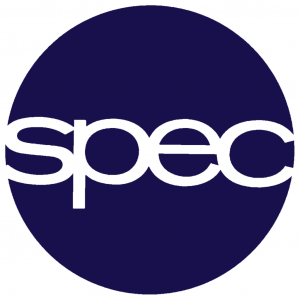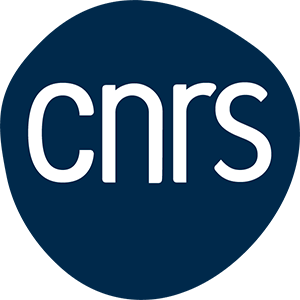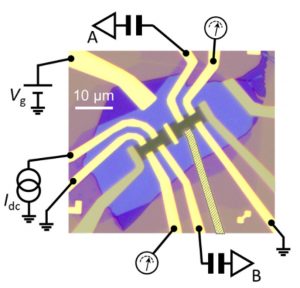Les modes neutres de l’effet Hall quantique fractionnaire échangent de l’énergie avec leurs homologues fractionnellement chargés, mais on ignore s’ils le font avec les canaux de bord de l’effet Hall quantique entier qui se trouvent à proximité. Pour répondre à cette question, des chercheurs du groupe Nanoélectronique du SPEC, en collaboration avec des équipes du C2N (Palaiseau, France) et du NIMS (Tsukuba, Japon) ont réalisé une expérience de transport de chaleur dans le graphène. En contrôlant la polarisation électrique des bords, ils observent une suppression maximale de la conductance thermique dans le régime de Hall quantique fractionnaire. C’est une signature claire des échanges d’énergie entre les canaux de bords entiers et les modes neutres. Ce travail répond ainsi à une question cruciale pour concevoir les futurs circuits quantiques dans le régime de Hall quantique.

The fractional quantum Hall effect is one of the most intriguing phenomena of condensed matter physics, where electronic interactions in a two-dimension electron gas subjected to a strong magnetic field lead to the emergence of highly exotic states with highly unusual properties. Among these, the existence of neutral edge modes, carrying only energy along the edges of the sample in a direction upstream to that of charge transport, has driven more than three decades of research. Their charge neutral nature has made them singularly challenging to probe, such that they were only first observed in 2010. Since then, many works have addressed the thermal transport properties of neutral modes, in particular whether they exchange energy with their neighboring counterpropagating charged edge modes. Significant progress was recently made on this topic, but an important question remained unanswered: can upstream neutral modes exchange energy and thermalize with integer-charged edge modes located up to several hundreds of nanometers away from them? This question is far from trivial, as it can profoundly change our understanding of the quantum Hall effect in terms of independent transport channels, and affect the realization of future experiments seeking to explore and exploit the remarkable properties of fractional quantum Hall states.

Edge structure of the ν=8/3 state of the quantum Hall effect. The thick red arrows represent the two integer-charged edge modes, the thin red arrow the fractional-charged edge mode, and the blue dashed arrow the neutral mode. Electrical conductances of each mode are given on the right side.
To address this question, we have performed heat transport measurements in a high quality graphene sample, by measuring the heat flow carried along the edge of the sample at very low temperatures and strong magnetic field. In the quantum Hall regime, the edge heat flow is quantized, generally reflecting the total number of ballistic integer and fractional edge modes flowing along the edge. Heat exchanges between the upstream neutral modes and the downstream charged modes decrease the edge heat flow: if all modes are fully thermalized, the heat flow reaches a quantized value given by the difference between the number of upstream and downstream modes. Importantly, if those two numbers are the same, the heat exchange are expected to take place over very large length, and can be essentially neglected.

Optical micrograph of the sample fabricated at C2N,
showing the wiring of the experiment. The graphene flake is highlighted in green.
We focused our investigation on the filling factor ν=8/3 of the fractional quantum Hall effect, the edge structure of which comprises two integer-charged downstream modes, one fractionally charged downstream mode and one upstream neutral mode. If the latter does not exchange energy with the integer modes, we expect to measure the equivalent quantized heat flow of 4 independent ballistic channels. If, on the contrary, the neutral mode fully thermalizes with the integer mode, it effectively suppresses the equivalent of a single ballistic channel; the heat flow thus is quantized to the equivalent of 2 ballistic channels.
Our results show that upon changing the edge electrostatics of our graphene sample, we were able to efficiently couple the neutral mode to the integer mode. This resulted in the observation of a transition from a non-equilibrated regime with a 4-channels quantized heat flow, to a fully equilibrated regime with a reduced 2-channels quantized heat flow.

Quantized heat flow at ν=8/3 measured as a function of the temperature. The non-equilibrated case is shown as dark red circles, and the equilibrated case as purple circles. The straight lines are the theoretical predictions for 4 and 2 channels quantized heat flow. The two cartoons illustrate the couplings between edge modes.
This work not only brings a clear answer on the energy exchanges between fractional and integer quantum Hall edge modes, but also stresses the central importance of edge electrostatics in the quantum Hall effect.
Référence :
Contacts :
- Contact CEA : François Parmentier (SPEC, Groupe Nanoélectronique)
Collaboration :




